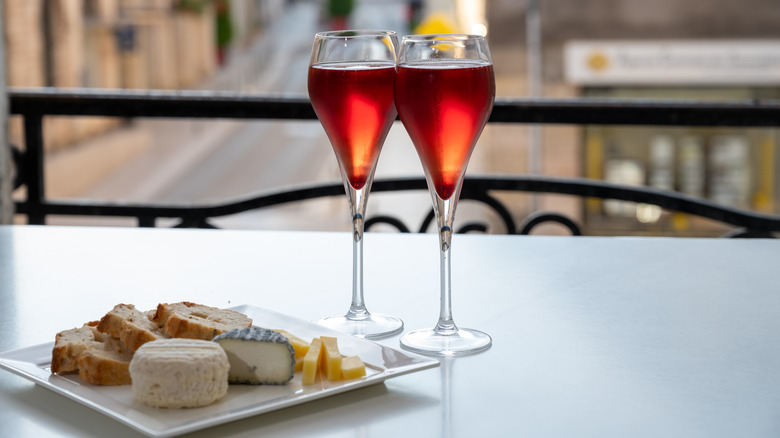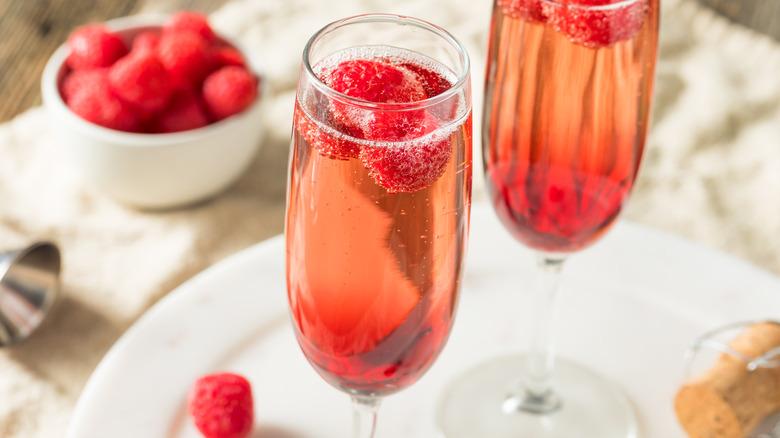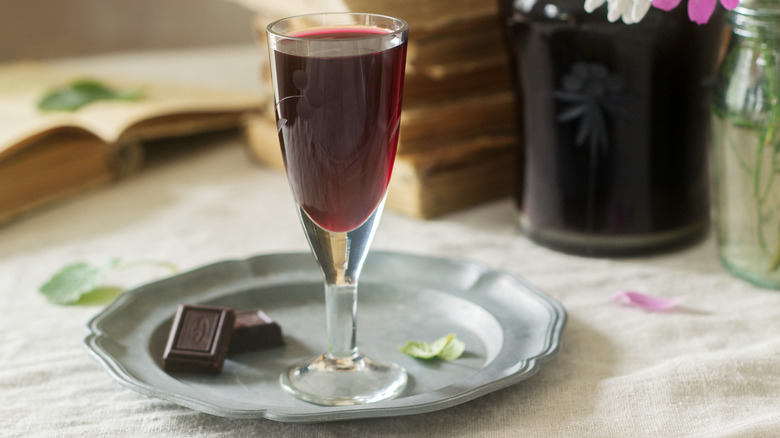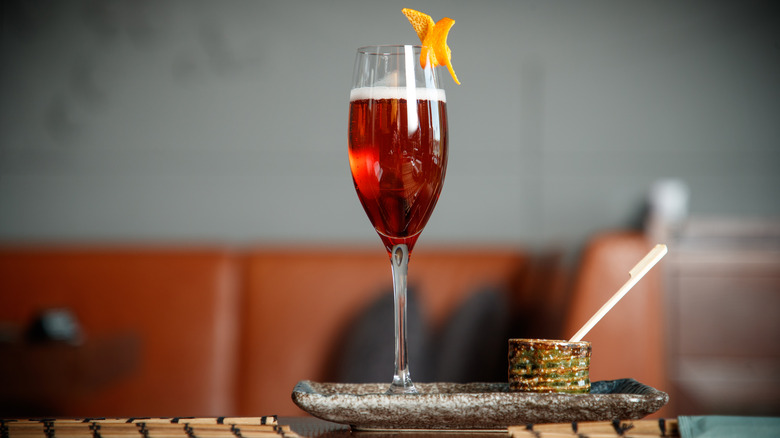Kir Royale Vs Kir Imperial: What's The Difference?
It's a lot easier to list what kir royales and kir imperials have in common than what they don't. Both classics are customarily served in flute glasses and sipped before dinner. They pair deliciously with delicate desserts for an unforgettable, decadent cocktail hour. The two beverages even share the same glamorous, dominantly French cocktail lineage. They're descendants of the eponymous "kir" cocktail, a classic aperitif made from crème de cassis and dry white Burgundy wine, traditionally Aligoté.
The two-parters are also cousins of the bubbly French 75 (gin, champagne, lemon, and simple syrup). But the kir family is comparatively relatively low-proof, like a fancy punch. So, what makes them different? It's all about one small yet crucial ingredient: the berry liqueur. Kir royales use crème de cassis (black current liqueur) and kir imperials use Chambord (raspberry liqueur), and the nuanced swap yields hugely different flavor results. Plus, both drinks are easy sippers best enjoyed on a patio or rooftop deck.
What is a kir royale?
The kir royale is a sparkling version of the classic kir cocktail, which, per the lore, first found an audience at Café George in Dijon — in the Burgundy region of France. Modern kir fans might have a mid-1900s industry plant to thank. The drink is named after Canon Félix Kir, the then-mayor (plus a priest and war hero) of Dijon, who allegedly popularized the cocktail by serving it to visiting dignitaries to showcase two of Dijon's prized regional ingredients: acidic white wine and cassis. The diplomats ostensibly dug it so much that they brought it back with them to their home countries. But, by whatever means, kir mania spread en masse after World War II, and it was such a popular cocktail that (among other reasons) Kir was reelected mayor of Dijon three more times before dying at age 92 (a downright bubbly legacy).
Kir royales are a timeless combination of sparkling wine and black currant crème de cassis, and they're super easy to assemble: Just pour a half-ounce of crème de cassis into the bottom of a flute glass and top with chilled Champagne. The result is a dark maroon hue and accessible ABV under 12%. A lemon twist or lemon wedge is customary to garnish, but a single fresh blackberry or (if your local farmers market is particularly well-stocked) a single black currant make for a fitting garnish as well.
What is a kir imperial?
Raspberries and champagne are a classic luxurious flavor pairing, and the kir imperial capitalizes on that glamour on all fronts. It's arguably the ultimate sipper for New Year's Eve parties, and if you haven't heard of it before, allow us the supreme pleasure of remedying that immediately. Similar to the kir royale, the kir imperial is a two-part combination of sparkling wine and raspberry liqueur. Rather than black currant crème de cassis, kir imperials use the raspberry liqueur known as Chambord for a fresh, sweet taste with balancing mild tartness that's perhaps more versatile for brunch, cocktail hour, or fabulous dinner parties. Chambord is packaged in a recognizable, distinctive spherical bottle with a gold band that's impressive to look at (and frankly super annoying to store in your home bar if you have limited space, but we digress).
Kir imperials also use the same assembly and ingredient proportions as the kir royale — roughly ½ ounce of berry liqueur topped with sparkling wine to fill the flute glass. Rather than ½ ounce, some folks use ¼ ounce of Chambord to build their kir variation cocktails. Feel free to play around with the proportions to suit your personal preference. More berry liqueur will yield a sweeter cocktail, while less will keep it dry, albeit with a less vivid aesthetic hue. To finish, garnish with a raspberry duo skewer balanced across the rim of the flute glass, or fresh mint leaves and an orange twist for a modern reimagining.
Crème de cassis versus Chambord
Chambord and crème de cassis are both types of French liqueur with a dark berry base. In addition to performing well as a cocktail ingredient, both liqueurs are also popularly enjoyed on their own straight up or over ice. But, that's about where their similarities end. If you've never tried it before, crème de cassis is a black currant liqueur with a violet hue and rich, dark depth cut with mild acidity. It features a sweet, tart blackberry flavor balanced with slightly bitter tannins for a mature profile that becomes almost devastatingly sophisticated when paired with the dry pungency from the brut champagne in a kir royale. The multidimensional ingredient might be better thought of as a viscous dark berry sweetener than as a berry liqueur.
By contrast, the kir imperial's Chambord is a raspberry-flavored liqueur from France's Loire Valley with an XO cognac base. Keeping it en français, it's also an essential ingredient in the French martini (vodka, Chambord, and pineapple juice). The elegant luxury spirit is made from a mix of raspberries, blackberries, black currants, honey, cinnamon, clove, ginger, Madagascar vanilla, and Moroccan citrus peel (a decidedly worldly elixir). Chambord's profile could ultimately be described as a raspberry flavor with some spiced depth. Crème de cassis is darker, whereas Chambord is brighter, which makes for markedly different kir cocktails.
Kir royale is drier and kir imperial is sweeter
As a result of the Chambord versus crème de cassis ingredient difference, kir royales are deeper and drier, while kir imperials are brighter and slightly sweeter. As such, the type of sparkling wine you use to assemble each drink should differ to complement the liqueurs' idiosyncrasies. French brut Champagne is always the way to go for kir royales. If you can't track one down in your local wine shop or liquor store, a dry Italian Prosecco or Spanish cava will get the job done — but then the cocktail will technically be called a kir pétillant ("sparkling kir"). French Blue Cremant de Bordeaux Brut (which retails for around $25) is a fantastic non-vintage sparkling wine tailor-made for a knockout kir royale without breaking the bank.
For more traditional prep, maintain the French brut Champagne in a kir imperial. But, compared to the kir royale, Chambord is a more versatile ingredient than crème de cassis for pairing with other, perhaps sweeter varieties of Champagne (which could ultimately be more budget-friendly depending on which brand you select). For an especially playful, fun pink drink, you could opt for a rosé Champagne such as Domaine de la Dentelle Bugey Cerdon Rose (which retails for around $30), a fruit, rose-forward, off-dry sparkling French rosé — not too sweet and not too stuffy.




